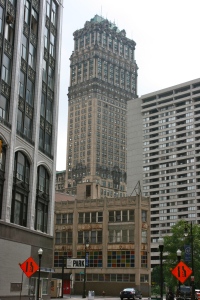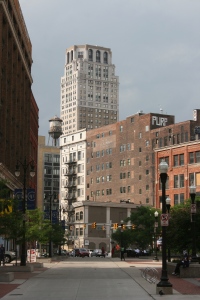Archive for the ‘detroit’ Tag
Downtown Detroit, 2016
A brief business trip brought me back to Detroit for the first time in a couple of years. While a wide swath of the city is rapidly disappearing, the high density stretch downtown to Midtown is regaining some of the hustle and bustle of years past. I don’t think the city will ever reach its postwar peak of 1.8 million again, but downtown is pretty stable, the demolitions have stopped, and work is underway on the new arena in anticipation of the move of the Red Wings and the return of the Pistons. I happened upon one of the free tours of the glorious art deco Guardian Building, which offers a detailed look at the jazzy, exuberant exterior and then takes in the view from the top floor, a rare view of Detroit from above that most visitors miss. Even with the unfortunate demolitions of numerous buildings starting in the 1970s, it’s a rich collection of early skyscrapers which thankfully won’t be going anywhere anytime soon. There’s lots of buzz downtown, with renovations, adaptive reuse, and residential conversions. The pre-Depression era skyscrapers are outstanding, mixed in with high quality mid-century designs that have stood the test of time. The skyline has changed little in 50 years, and here’s a few pictures of the blocks around the Guardian Building.

The vaulted lobby of the Guardian Building (Wirt Rowland, 1929), decorated with Pewabic tile. It’s hard to imagine that this lobby once featured a dropped ceiling that hid all of this tilework, before a 2003 renovation set things right!
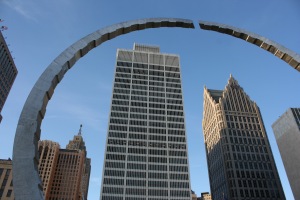
And from Hart Plaza, Minoru Yamasaki’s elegant One Woodward (1963), and Johnson and Burgee’s postmodern One Detroit Center (1992), framed by the sculpture Transcending (2003).
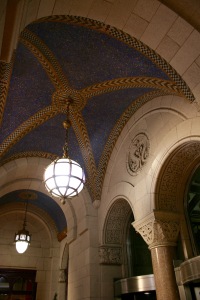
The Romanesque entryway of the Buhl Building (Wirt Rowland, 1925). Yup, same designer as the Guardian across the street, completely different style.
Downtown Detroit, 2013
This is one of America’s great architectural treasures, but in a precarious state. Buildings are coming down quickly, many are vacant, and you just never know what will exist tomorrow. Laid out on a unique grid of radiating spokes from Campus Martius Park, the blocks are irregular, with numerous hidden spaces, pocket-sized parks and squares, and unusual buildings. The bulk of the skyline has changed little over the past 60 years, and certain sections are a real window back to the heyday of Detroit in the first half of the 20th century.
Despite Detroit’s 60-year streak of bad luck, declining population, and financial troubles, downtown is one of the success stories. Once derelict buildings are being converted into apartments, there is new construction (although at the expense of some distinguished buildings being torn down), and there is a feeling of cohesion between downtown and the New Center. The bad news continues to be in neighborhoods that have effectively emptied out.
Bagley Memorial Fountain, Detroit
This is one of Detroit’s little gems, and H.H. Richardson’s only work in Michigan. Since its completion in 1887, it’s wandered from place to place downtown. Now it’s nicely restored, cleaned up, and sits in the middle of Cadillac Square, a few hundred feet east of Campus Martius. The carvings are exquisite, with a delicacy in contrast to Richardson’s rather muscular structures elsewhere. Too bad it’s a dry fountain, hopefully the water will be turned on at some point.
Detroit, May 2009
Last of a series of long weekends in Germany, so I pounced on a cheap flight, got an excellent hotel and car rental deal via Priceline, and spent the weekend in Detroit. Oh, and I spent Sunday biking through the city.
Detroit? Pretty much nothing but bad news coming out of there these days, except for the Red Wings. The city has become synonymous with urban decay, murder, poverty, and the ills of the auto industry, and not a whole lot of positive stuff has been reported about Detroit for many decades now. But let’s not forget that the city was a thriving place of 2 million people nearly sixty years ago, built on the automobile industry, and on immigration from central and eastern Europe, with some of America’s very best architecture. So I’ve been fascinated by this place, and finally had the chance to visit.
The glory days are long over. Many buildings are now endangered, and the once great boulevards of the city, Michigan Avenue, Gratiot, Grand River, are shells of their former selves. Only Woodward, the main north-south artery, retains its former grandeur. The churches of Detroit are also for the most part, in good condition, albeit with dwindling congregations. The once-German and Polish neighborhoods have been depopulated, most noticeably during the 1950s and after the 1967 riots that decimated the city.
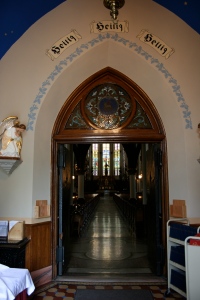
St. Joseph's, just off of Gratiot. Still regular services in Latin and German!
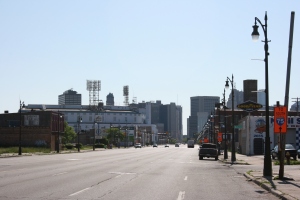
Michigan Avenue from near the station, looking east. The remains of Tiger Stadium are on the left.
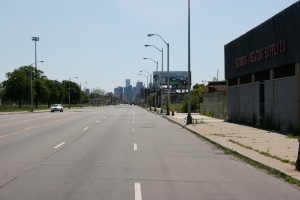
Grand River Ave.
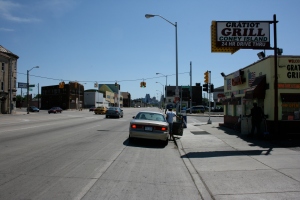
Gratiot Ave.
Downtown is a treasure trove of distinguished skyscrapers from the first three decades of the 20th century, but as with much of the city, please go visit now, because there’s no guarantee that it will be there tomorrow. The area around Grand Circus Park remains a skyscraper graveyard, and many buildings are empty or abandoned. Parking garages seem to be almost as common as buildings. The few bright spots include the recent renovations of the Book Cadillac Hotel and the Fort Shelby, which have brought back a bit of life into the west downtown area. The Penobscot and Guardian Buildings are looking as good as new, as well. I’ll write more about the architecture in another post.
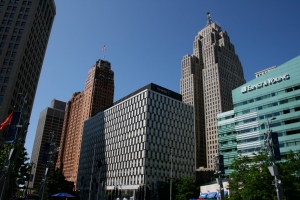
Downtown from Campus Martius
The neighborhoods, well, they are a different story. Inner Detroit is rapidly becoming an urban prairie. The great commercial arteries are now quite empty, with an odd business open here and there, but clearly unhealthy. So pretty much, the city is down to pockets of neighborhoods, with relatively few cohesive stands of houses. Despite this, Detroiters remain fiercely proud of their city, and a remarkably friendly bunch.
One exception to the depopulation of neighborhoods is west and southwest Detroit, which are thriving thanks to a wave of immigrants from Mexico. And outside the city, in Hamtramck and Dearborn, a new generation of immigrants from the Middle East and Eastern Europe have kept them very robust, interesting places to visit. Restoration of Detroit’s historic neighborhoods is ongoing, although too late for inner city areas such as Brush Park and the region east of the Medical Center. Some blocks have just a house or two left standing, the remainder is a large lawn. Even more odd, more often than not, the one or two houses left on the block are perfectly maintained, even inviting. Nevertheless, the restored houses give a glimpse into the once-grand past of the city.
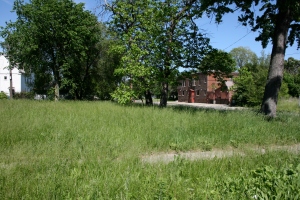
The Polish Yacht Club, Jos. Campau Street, still in business!
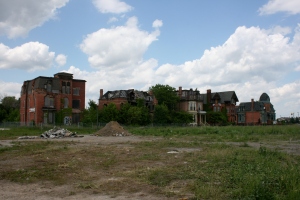
Brush Park survivors
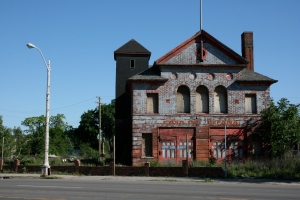
Ex-firehouse, Michigan Avenue
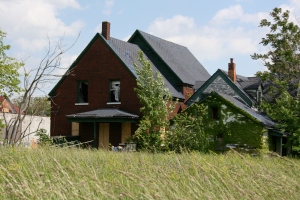
Little house on the (urban) prairie
And a few words about Michigan Central Station, probably America’s most famous ruin, beautiful and depressing all at the same time. The location was strategic and wrong. Strategic because it was at the Detroit end of the tunnel to Canada, wrong because the developers thought that downtown would expand west, which it didn’t. The park leading to the station is a beautiful piece of city planning, but now sadly overgrown and empty. The station was abandoned in 1988 when the last Amtrak train rolled through it, and has been weathered by vandals and the elements since then. Still, plenty of people wander around and inside it, and I was treated to an impromptu jazz concert from a lone clarinetist playing one evening. The massive building dominates the nearby Corktown and Mexicantown neighborhoods, and is now threatened with “expedited demolition”. See it while you can.
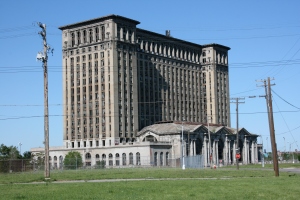
Michigan Central Station
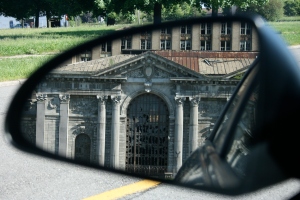
Neighboring Dearborn remains the center of the Arab-American community, and Hamtramck, an oasis of stability surrounded by Detroit, is a fascinating mix of people of Polish descent, mixed in with more recent arrivals from diverse places like Yemen, Ukraine, Albania, Bosnia, and Bangladesh. I found a small-town feel in Detroit, where people were willing to stop and chat with a total stranger like myself, and I didn’t feel as anonymous as I do in Germany.

Kowalski Sausage Company, Hamtramck
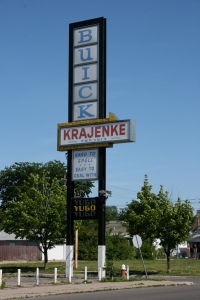
Krajenke Buick and Yugo, closed since 1992.
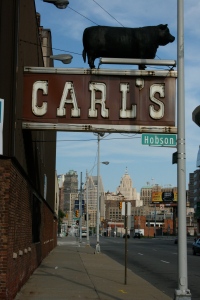
Carl's Chop House on Grand River Ave., closed 2008. Given the surroundings, not a surprise.
 Leave a comment
Leave a comment
